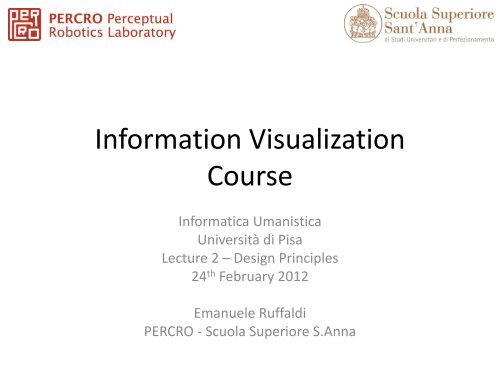Create successful ePaper yourself
Turn your PDF publications into a flip-book with our unique Google optimized e-Paper software.
Information Visualization<br />
Course<br />
Informatica Umanistica<br />
Università di Pisa<br />
Lecture 2 – Design Principles<br />
24 th February 2012<br />
Emanuele Ruffaldi<br />
PERCRO - Scuola Superiore S.Anna
• Graphical Integrity<br />
• Design Principle<br />
• Design Elements<br />
Overview
Data must tell the truth<br />
GRAPHICAL INTEGRITY
Missing Scales<br />
Tufte, VDQI
Missing Scales<br />
Tufte, VDQI
Lie Factor<br />
(Size of effect in graphic) / (size of effect in data)
Lie Factor
Lie Factor<br />
"The logarithm of the Lie Factor can be<br />
taken in order to compare overstating (log<br />
LF > 0) with understating (log LF < 0)<br />
errors."<br />
Tufte, VDQI p. 57
Design Distortions<br />
Show Data Variations and not Design<br />
Variation<br />
•1973-1978: one vertical inch<br />
equals to $8.00. In 1979,<br />
One vertical inch equals $3-4<br />
• 1973-1978: one horzontal inch<br />
equals 3.7 years, while 1979<br />
equals 0.57 year
Scale Distortions
Scale Distortions
Context and Scale
Context and Scale
Context
Context
Context
Context
http://junkcharts.typepad.com/<br />
Junk Charts
Junk Chart 1
Junk Chart 2
Junk Chart 3
Junk Chart 4
Decomposition
Hierarchical Display
Show the data, tell the truth, help the viewer think about the information<br />
rather than the design, encourage the eye to compare the data, make<br />
large data sets coherent<br />
DESIGN PRINCIPLES
Maximize Data-Ink Ratio<br />
• Data-ink = the ink used to show data<br />
• Data-ink ratio = data-ink / total ink used
Maximize Data-Ink Ratio<br />
• Data-ink = the ink used to show data<br />
• Data-ink ratio = data-ink / total ink used
Data Density
Escaping Flatland<br />
http://www.historyshots.com/ViewInfo.cfm?Type=zoom&PID=1010
Escaping Flatland
Interactive Demo<br />
http://omnipotent.net/jquery.sparkline/<br />
Sparklines (Tufte)<br />
BE,Tufte<br />
Chapter<br />
http://www.edwardtufte.com/bboard/q-and-afetch-msg?msg_id=0001OR
Chartjunk<br />
Extraneous visual elements that distract from<br />
the message<br />
http://www.tbray.org/ongoing/data-ink/di1
Morié Vibrations
Grids as Chart Junk
The Duck<br />
Self-promoting graphics: when the data<br />
measures become design elements
Example<br />
Amount that a Colorado state prisoner is paid to work a day as a field hand at<br />
a local farm: 60¢<br />
Amount the prisons are paid by farmers for each inmate's daily work: $77.20
• World Population in 2008
World Population in 2008
Tufte Design Principles<br />
• Above all else show the data<br />
• Maximize data-ink ratio<br />
• Erase non-data ink<br />
• Erase redundant data ink<br />
• Revise and edit
Thinking with Visualization
Subjective Dimensions<br />
• Aesthetics: Attractive things are perceived as<br />
more useful than unattractive ones<br />
• Style: Communicates brand, process, who the<br />
designer is<br />
• Playfulness: Encourages experimentation and<br />
exploration<br />
• Vividness: Can make a visualization more<br />
memorable
DESIGN ELEMENTS
• Contrast<br />
• Repetition<br />
• Alignment<br />
• Proximity<br />
• + Composition<br />
CRAP
Contrast<br />
• Contrast between Colors
Contrast
Contrast
Repetition
Alignment
Proximity
Small Multiplies<br />
Small multiple designs, multivariate and data bountiful, answer directly by<br />
visually enforcing comparisons of changes, of the differences among<br />
objects, of the scope of alternatives. For a wide range of problems in data<br />
presentation, small multiples are the best design solution (EI, p. 67)
Small Multiplies<br />
Tufte, VDQI
Trellis Chart<br />
Tonga Trench Earthquakes<br />
Yellow: 0 − 70 km<br />
Orange: 71 − 300 km<br />
Red: 300 − 800 km.
Trellis Chart
Elements of Trellis Chart<br />
• Every Trellis display consists of a series of<br />
rectangular panels, laid out in a regular row-bycolumn<br />
array.<br />
• The indexing of the array is left-to-right, bottomto-top.<br />
• The x axes of all the panels are identical. This is<br />
also true for the y axes.<br />
• Each panel of the a display corresponds to<br />
conditioning, either on the levels of a factor, or<br />
on sub-intervals of the range of a numeric<br />
variable.
Trellis Chart<br />
• The conditioning carried out in the earthquake<br />
plot is described by a shingle.<br />
• A shingle consists of a number of overlapping<br />
intervals (like the shingles on a roof of a<br />
house).
Small Multiplies<br />
Tufte, VDQI
Layering and Separation
Layering and Separation
Layering and Separation
Balance Positive<br />
and Negative Space
Negative Space
• Color<br />
• Line and Form<br />
• Typography<br />
Other Design Elements<br />
• Format and Scale
Format and Scale
• Simplicity<br />
• Clarity<br />
• Uncluttered<br />
• Restraint<br />
Aesthetics
Exercise<br />
1. Take a set of data from recent news<br />
e.g. from Harper’s Index<br />
http://www.harpers.org/subjects/HarpersIndex<br />
2. Design Graph Interpretation of that<br />
information<br />
3. Apply <strong>graphical</strong> principles discussed
References<br />
• BE: Tufte, E. R. (2006). Beautiful evidence.<br />
Cheshire, CT: Graphics Press<br />
• EI: Tufte, E.R. (1990) Envisioning Information,<br />
Cheshire, CT, Graphics Press.<br />
• VDQI: Tufte, E. R. (1983) The Visual Display of<br />
Quantitative Information, Cheshire, CT:<br />
Graphics Press.
These slides are subject to the License<br />
Creative Commons<br />
Attribution-Noncommercial-Share Alike 2.5 Italy


